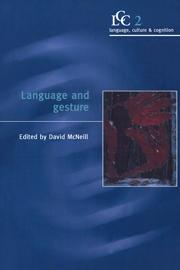Book contents
- Frontmatter
- Contents
- Acknowledgments
- Introduction
- Part 1 Gesture in action
- Part 2 Gesture in thought
- Part 3 Modeling gesture performance
- 13 Lexical gestures and lexical access: a process model
- 14 The production of gesture and speech
- 15 Catchments and contexts: non-modular factors in speech and gesture production
- Part 4 From gesture to sign
- Index
14 - The production of gesture and speech
Published online by Cambridge University Press: 07 January 2010
- Frontmatter
- Contents
- Acknowledgments
- Introduction
- Part 1 Gesture in action
- Part 2 Gesture in thought
- Part 3 Modeling gesture performance
- 13 Lexical gestures and lexical access: a process model
- 14 The production of gesture and speech
- 15 Catchments and contexts: non-modular factors in speech and gesture production
- Part 4 From gesture to sign
- Index
Summary
Introduction
Research topics in the field of speech-related gesture that have received considerable attention are the function of gesture, its synchronization with speech, and its semiotic properties. While the findings of these studies often have interesting implications for theories about the processing of gesture in the human brain, few studies have addressed this issue in the framework of information processing.
In this chapter, I will present a general processing architecture for gesture production. It can be used as a starting point for investigating the processes and representations involved in gesture and speech. For convenience, I will use the term ‘model'when referring to ‘processing architecture’ throughout this chapter.
Since the use of information-processing models is not believed by every gesture researcher to be an appropriate way of investigating gesture (see, e.g., McNeill 1992), I will first argue that information-processing models are essential theoretical tools for understanding the processing involved in gesture and speech. I will then proceed to formulate a new model for the production of gesture and speech, called the Sketch Model. It is an extension of Levelt's (1989) model for speech production. The modifications and additions to Levelt's model are discussed in detail. At the end of the section, the working of the Sketch Model is demonstrated, using a number of illustrative gesture/speech fragments as examples.
Subsequently, I will compare the Sketch Model with both McNeill's (1992) growth-point theory and with the information-processing model by Krauss, Chen & Gottesman (this volume). While the Sketch Model and the model by Krauss et al. are formulated within the same framework, they are based on fundamentally different assumptions.
- Type
- Chapter
- Information
- Language and Gesture , pp. 284 - 311Publisher: Cambridge University PressPrint publication year: 2000
- 169
- Cited by



